HPLC-DAD Analysis of Hemp Oil Supplements for Determination of Four Cannabinoids: Cannabidiol, Cannabidiolic Acid, Cannabinol and Delta 9-Tetrahydrocannabinol
Abstract
:1. Introduction
2. Experimental
2.1. Standards and Reagents
2.2. Examined Materials
- Supplement I: dark yellow hemp oil (5% CBD);
- Supplement II: yellow-green hemp oil (5% CBD);
- Supplement III: dark yellow hemp oil (5% CBD);
- Supplement IV: dark brown hemp oil-resin (18.87% CBD, 27.01% CBDA, CBN 0.01%, 0.29% Δ9-THC)—this supplement was at the stage of implementation for sale and was not introduced to the market;
- Supplement V: light yellow hemp oil (10% CBD);
- Supplement VI: yellow hemp oil (5% CBD);
- Supplement VII: dark yellow hemp oil (10% CBD).
2.3. Apparatus and Laboratory Equipment, Chromatographic Conditions
2.4. Standard Oil Samples Preparation
2.5. Determination of Main Analytical Parameters of the Method
2.6. Supplements Preparation
3. Results and Discussion
4. Conclusions
Author Contributions
Funding
Institutional Review Board Statement
Informed Consent Statement
Conflicts of Interest
References
- Canadian Food Inspection Agency (Canada.ca). The Biology of Cannabis sativa L. (Cannabis, hemp, marijuana). Available online: https://inspection.canada.ca/plant-varieties (accessed on 4 November 2021).
- Hodgson, E. Chapter Fourteen—Toxins and Venoms. Prog. Mol. Biol. Transl. Sci. 2012, 112, 373–415. [Google Scholar]
- Protti, M.; Brighenti, V.; Battaglia, M.R.; Anceschi, L.; Pellati, F.; Mercolini, L. Cannabinoids from Cannabis sativa L.: A New Tool Based on HPLC-DAD-MS/MS for a rational use in medicinal chemistry. ACS Med. Chem. Lett. 2019, 10, 539–544. [Google Scholar] [CrossRef] [PubMed]
- Anderson, L.L.; Low, I.K.; Banister, S.D.; McGregor, I.S.; Arnold, J.C. Pharmacokinetics of phytocannabinoid acids and anticonvulsante of cannabidiolic acid in a mouse model of Dravet Syndrome. J. Nat. Prod. 2019, 82, 3047–3055. [Google Scholar] [CrossRef] [Green Version]
- SwissADME. Available online: http://www.swissadme.ch/index.php (accessed on 4 November 2021).
- United Nations Office on Drugs and Crime. Recommended Methods for the Identification and Analysis of Cannabis and Cannabis Products, Vienna, New York. 2013. Available online: https://www.un-ilibrary.org/content/books/9789210555890 (accessed on 11 October 2021).
- Battista, N.; Di Tommaso, M.; Bari, M.; Maccarone, M. The endocannabinoid system: An overview. Front. Behav. Neurosci. 2012, 6, 9. [Google Scholar] [CrossRef] [PubMed] [Green Version]
- Ehrenkranz, J.; Levine, M.A. Bones and Joints: The effects of cannabinoids on the skeleton. J. Clin. Endocrinol. Metab. 2019, 104, 4683–4694. [Google Scholar] [CrossRef] [PubMed]
- Borowska, M.; Czarnywojtek, A.; Sawicka-Gutaj, N.; Woliński, K.; Płazińska, M.T.; Mikołajczak, P.; Ruchała, M. The effects of cannabinoids on the endocrine system. Endokrynol. Pol. 2018, 69, 705–719. [Google Scholar] [CrossRef] [Green Version]
- Van de Donk, T.; Niesters, M.; Kowal, M.A.; Olofsen, E.; Dahan, A.; Van Velzen, M. An experimental randomized study on the analgesic effects of pharmaceutical-grade cannabis in chronic pain patients with fibromyalgia. Pain 2019, 160, 860–869. [Google Scholar] [CrossRef]
- Ulugöl, A. The Endocannabinoid system as a potential therapeutic target for pain modulation. Balkan Med. J. 2014, 31, 115–120. [Google Scholar] [CrossRef]
- Takeda, S.; Okajima, S.; Miyoshi, H.; Yoshida, K.; Okamoto, Y.; Okada, T.; Amamoto, T.; Watanabe, K.; Omiecinski, C.J.; Aramaki, H. Cannabidiolic acid, a major cannabinoid in fiber-type cannabis, is an inhibitor of MDA-MB-231 breast cancer cell migration. Toxicol. Lett. 2012, 214, 314–319. [Google Scholar] [CrossRef] [Green Version]
- Alexander, A.; Smith, P.F.; Rosengren, R.J. Cannabinoids in the treatment of cancer. Cancer Lett. 2009, 285, 6–12. [Google Scholar] [CrossRef]
- Bolognini, D.; Rock, E.M.; Cluny, N.L.; Cascio, M.G.; Limebeer, C.L.; Duncan, M.; Stott, C.G.; Javid, F.A.; Parker, L.A.; Pertwee, R.G. Cannabidiolic acid prevents vomiting in Suncus murinus and nausea-induced behaviour in rats by enhancing 5-HT1A receptor activation. Br. J. Pharmacol. 2013, 168, 1456–1470. [Google Scholar] [CrossRef] [Green Version]
- Grant, I.; Cahn, B.R. Cannabis and endocannabinoid modulators: Therapeutic promises and challenges. Clin. Neurosci. Res. 2005, 5, 185–199. [Google Scholar] [CrossRef] [Green Version]
- Cairns, E.A.; Baldridge, W.H.; Kelly, M.E. The Endocannabinoid system as a therapeutic target in glaucoma. Neural Plast. 2016, 2016. [Google Scholar] [CrossRef] [PubMed] [Green Version]
- Holgado, M.A.; Martín-Banderas, L.; Álvarez-Fuentes, J.; Fernández-Arévalo, M. Neuroprotective effect of cannabinoids nanoplatforms in neurodegenerative diseases. J. Drug Deliv. Sci. Technol. 2017, 42, 84–93. [Google Scholar] [CrossRef]
- Maurya, N.; Kumur Velmurugan, B. Therapeutic applications of cannabinoids. Chem. Biol. Inter. 2018, 293, 77–88. [Google Scholar] [CrossRef] [PubMed]
- Millar, S.A.; Stone, N.L.; Yates, A.S.; O’Sullivan, S.E. A systematic review on the pharmacokinetics of cannabidiol in humans. Front. Pharmacol. 2018, 9, 1365. [Google Scholar] [CrossRef]
- McRae, G.; Melanson, J.E. Quantitative determination and validation of 17 cannabinoids in cannabis and hemp using liquid chromatography–tandem mass spectrometry. Anal. Bioanal. Chem. 2020, 412, 7381–7393. [Google Scholar] [CrossRef] [PubMed]
- Lee, J.H.; Min, A.Y.; Han, J.H.; Yang, Y.J.; Kim, H.; Shin, D. Development and validation of LC-MS/MS method with QuEChERS clean-up for detecting cannabinoids in foods and dietary supplements. Food Add. Contamin. Part. A 2020, 37, 1413–1424. [Google Scholar] [CrossRef]
- Cardenia, V.; Toschi, T.G.; Scappini, S.; Rubino, S.C.; Rodriguez-Estrada, M.T. Development and validation of a Fast gas chromatography/mass spectrometry method for the determination of cannabinoids in Cannabis Sativa L. J. Food Drug Anal. 2018, 26, 1283–1292. [Google Scholar] [CrossRef] [PubMed]
- Zekiĉ, J.; Križman, M. Development of Gas-Chromatographic Method for Simultaneous Determination of Cannabinoids and Terpenes in Hemp. Molecules 2020, 25, 5872. [Google Scholar] [CrossRef]
- Ciolino, L.A.; Ranieri, T.L.; Taylor, A.M. Commercial cannabis consumer products part 2: HPLC-DAD quantitative analysis of cannabis cannabinoids. Forensic. Sci. Int. 2018, 289, 438–447. [Google Scholar] [CrossRef]
- Mudge, E.M.; Murch, S.J.; Brown, P.N. Leaner and greener analysis of cannabinoids. Anal. Bioanal. Chem. 2017, 409, 3153–3163. [Google Scholar] [CrossRef] [Green Version]
- Tzimas, P.S.; Petrakis, E.A.; Halabalaki, M.; Skaltsounis, L.A. Effective determination of the principal non-psychoactive cannabinoids in fiber-type Cannabis sativa L. by UPLC-PDA following comprehensive design and optimization of extraction methodology. Anal. Chim. Acta 2021, 1150, 338200. [Google Scholar] [CrossRef]
- Szabady, B.; Hidwégi, E.; Nyiredy, S.Z. Determination of Neutral Cannabinoids in Hemp Samples by Overpressured-Layer Chromatography. Chromatographia 2002, 56, 165–168. [Google Scholar] [CrossRef]
- Barthlott, I.; Scharinger, C.H.; Golombek, P.; Kuballa, T.; Lachenmeier, D.W. A Quantitative 1 H NMR Method for Screening of Cannabinoids in CBD Oils. Toxics 2021, 9, 136. [Google Scholar] [CrossRef] [PubMed]
- Patel, B.; Wene, D.; Fan, Z.T. Qualitative and quantitative measurement of cannabinoids in cannabis using modified HPLC/DAD method. J. Pharmaceut. Biomed. Anal. 2017, 146, 15–23. [Google Scholar] [CrossRef]
- Ilias, Y.; Rudaz, S.; Mathieu, P.; Christen, P.; Veuthe, J.-C. Extraction and analysis of different Cannabis samples by headspace solid-phase microextraction combined with gas chromatography-mass spectrometry. J. Sep. Sci. 2005, 28, 2293–2300. [Google Scholar] [CrossRef] [PubMed]
- Drinić, Z.; Vladić, J.; Koren, A.; Zeremski, T.; Stojanov, N.; Kiprovski, B.; Vidović, S. Microwave-assisted extraction of cannabinoids and antioxidants from Cannabis sativa aerial parts and process modeling. J. Chem. Technol. Biotechnol. 2020, 95, 831–839. [Google Scholar] [CrossRef]
- Elkins, A.C.; Deseo, M.A.; Rochfort, S.; Ezernieks, V.; Spangenberg, G. Development of a validated method for the qualitative and quantitative analysis of cannabinoids in plant biomass and medicinal cannabis resin extracts obtained by super-critical fluid extraction. J. Chromatogr. B Anal. Technol. Biomed. Life Sci. 2019, 1109, 76–83. [Google Scholar] [CrossRef]
- Nemeškalováa, A.; Hájkováa, K.; Mikulůb, L.; Sýkoraa, D.; Kuchařb, M. Combination of UV and MS/MS detection for the LC analysis of cannabidiol-rich products. Talanta 2020, 219, 121250. [Google Scholar] [CrossRef]
- Deville, M.; Dubois, N.; Denooz, R.; Charlier, C. Validation of an UHPLC/DAD method for the determination of cannabinoids in seized materials: Analysis of 213 samples sold in Belgian CBD shops. Forensic. Sci. Int. 2020, 310, 110234. [Google Scholar] [CrossRef] [PubMed]
- Pellegrini, M.; Marchei, E.; Pacifici, R.; Pichin, S. A rapid and simple procedure for the determination of cannabinoids in hemp food products by gas chromatography-mass spectrometry. J. Pharm. Biomed. Anal. 2005, 36, 939–946. [Google Scholar] [CrossRef]
- Citti, C.; Pacchetti, B.; Vandelli, M.A.; Forni, F.; Cannazza, G. Analysis of cannabinoids in commercial hemp seed oil and decarboxylation kinetics studies of cannabidiolic acid (CBDA). J. Pharm. Biomed. Anal. 2018, 149, 532–540. [Google Scholar] [CrossRef] [PubMed]
- Madej, K.; Kózka, G.; Winiarski, M.; Piekoszewski, W. A simple, fast, and green oil sample preparation method for determination of cannabidioloic acid and cannabidiol by HPLC-DAD. Separations 2020, 7, 60. [Google Scholar] [CrossRef]
- Deidda, R.; Avohou, H.T.; Baronti, R.; Davolio, P.R.; Pasquini, B.; Del Bubba, M.; Hubert, C.; Hubert, P.; Orlandini, S.; Furlanetto, S. Analytical quality by design: Development and control strategy for a LC method to evaluate the cannabinoids content in cannabis olive oil extracts. J. Pharm. Biomed. Anal. 2019, 166, 326–335. [Google Scholar] [CrossRef]

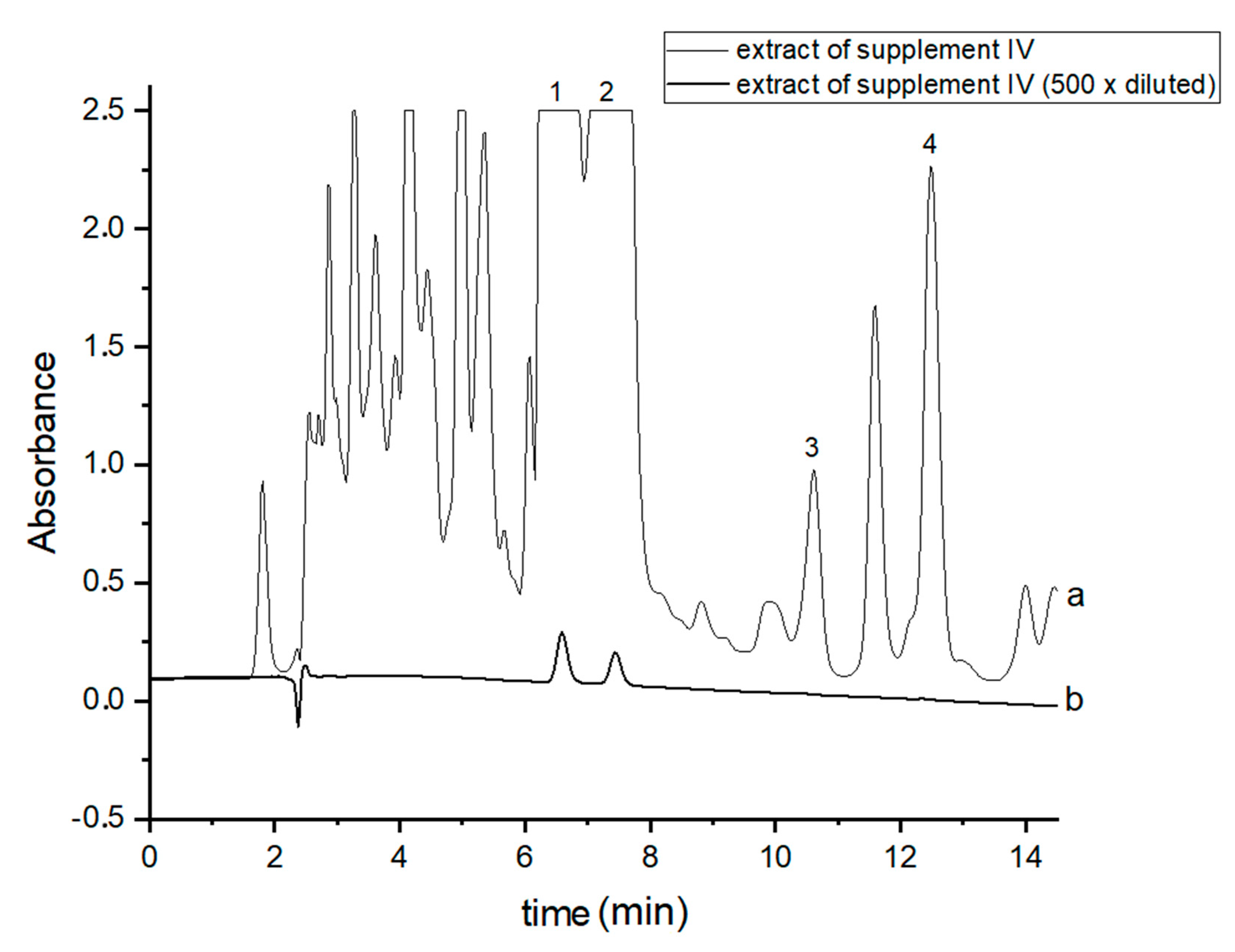

| Cannabinoid | Chemical Structure | logS a | -logKa b | logPo/w c | Observed Characteristic Absorption Maximum d (nm) |
|---|---|---|---|---|---|
| CBDA (cannabidiolic acid) | 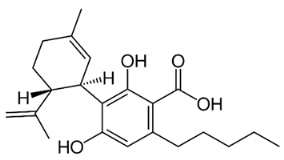 | −5.93 | 3.41 | 4.86 e | 270 |
| CBD (cannabidiol) | 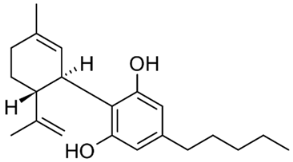 | −5.69 | 9.64 | 5.20 e 5.79 f | 275 |
| CBN (cannabinol) | 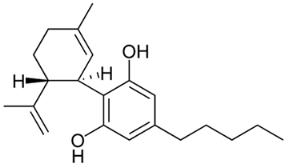 | −5.74 | 9.40 | 5.21 e 6.23 f | 280 |
| ∆9-THC (delta-9-tetrahydrocannabinol) | 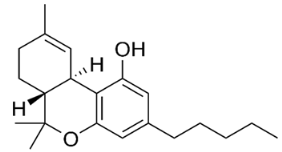 | −6.11 | 10.6 | 5.28 e 6.99 f | 275 |
| Parameter | CBDA | CBD | CBN | ∆9-THC |
|---|---|---|---|---|
| Slope of the straight line, a | 27,598 | 23,609 | 39,194 | 19,565 |
| Straight line intercept, b | −4728.9 | 45,721 | −15,196 | −11,745 |
| Linearity range (µg/mL) | 0.78–25 | 3.12–50 | 0.78–25 | 1.56–25 |
| Determination coefficient, R2 | 0.9986 | 0.9976 | 0.9976 | 0.9993 |
| LOD (µg/mL) | 0.17 | 1.94 | 1.68 | 0.65 |
| LOQ (µg/mL) | 0.78 | 3.12 | 5.03 | 1.95 |
| Intra-day precision (RSD, %), at 2 µg/mL (n = 5) | 8.07 | - a | 4.79 | 11.44 |
| Intra-day precision (RSD, %), at 20 µg/mL (n = 5) | 10.47 | 5.38 | 8.47 | 9.09 |
| Extraction recovery with (RSD (%), at 2 µg/mL, n = 5) | 69.5 (7.1) | 97.3 (8.4) | 71.2 (10.6) | 67.1 (10.9) |
| Extraction recovery with (RSD (%), at 20 µg/mL, n = 5) | 69.1 (10.6) | 109.5 (5.0) | 74.4 (4.9) | 66.9 (6.1) |
| Cannabinoids | Sample Amount | Sample Preparation | Extraction Solvent/Solvent Volume | Range of Linearity (μg/mL) | LOD/LOQ (μg/mL) | Precision (RSD, %) | Ref |
|---|---|---|---|---|---|---|---|
| 8 cannabinoids including CBDA, CBD, CBN and Δ9-THC | 50 mg | Vortexing (for 30 s), onication (for 15 min) with vortexing every 5 min, filtration with 0.22 µm Teflon filters | Methanol/10 mL | 5–250 for CBDA (R2 > 0.999) 1–50 for CBD (R2 > 0.998) 0.5–25 for CBN (R2 > 0.999) 1.0–50 for Δ9-THC (R2 > 0.998) | - a | 1.2–2.0 (CBD) 0.5–3.1 (CBDA) 0.9–4.3 (Δ9-THC) | [25] |
| CBDA, CBD, CBN, Δ9-THC, THCA | - b | Vortexing and sonication (for 15 min), filtration through a 0.45 µm nylon membrane disc filters | 95% ethanol/- b | 0.5–1000 | - b | 3.0 (CBDA) 8.9 (CBD) | [24] |
| 7 cannabinoids including CBDA, CBD, CBN and Δ9-THC | 250 mg | Vortexing (for 15 min), filtration through 0.2 μm filter | Ethyl acetate: isopropanol (1:1, v/v)/5 mL | 1–10 (CBD) c | Δ9-THC: 1.0 c | 7.7% (CBD)c | [33] |
| 7 cannabinoids including CBDA, CBD, CBN and Δ9-THC | 100 μL | Dilution with 2-propanol and IS solution, then vortex mixing for 1 min and directly injected into apparatus | - d | 1–10 (R2 > 0.994) | 1.0 | 1.0–6.3 (CBDA) 0.4–3.9 (CBD) 0.1–6.1 (CBN) 0.6–3.7 (Δ9-THC) | [36] |
| CBD, Δ9-THC | - a | - a | - a | 1–40 (R2 > 0.998) | 1.0 | 0.51–2.02 (CBD) 0.64–1.28 (Δ9-THC) | [38] |
| CBDA, CBD, CBN and Δ9-THC | 100 mg | Vortexing (for 1 min), rocker shaker (15 min), then fat freezing (15 min) | Acetonitrile/0.5 mL | 0.78–25 (CBDA) 3.13–50 (CBD) 0.78–25 (CBN) 1.56–25 (Δ9-THC) | CBD: 1.94/3.12 CBDA: 0.17/0.78 CBN: 1.68/5.03 Δ9-THC: 0.65/1.95 | 5.0–8.4 (CBD) 7.1–10.6 (CBDA) 4.79–8.47 (CBN) 9.09–11.44 (Δ9-THC) | This work |
| Supplement | Cannabinoids in the Examined Supplements (%, w/w) | |||
|---|---|---|---|---|
| CBDA | CBD | CBN | ∆9-THC | |
| I (5% CBD) a | 1.04 | 1.45 | 0.02 | - c |
| II (5% CBD) a | 0.035 | 4.82 | 0.003 | - c |
| III (5% CBD) a | 0.84 | 1.81 | 0.008 | - c |
| IV (oil-resin) b (27.01% CBDA 18.87% CBD 0.01 CBN 0.29% Δ9-THC) a | 25.75 | 18.25 | 0.35 | 0.84 |
| V (10% CBD) a | 0.55 | 10.25 | 0.013 | 0.198 |
| VI (5% CBD) a | 0.30 | 4.54 | 0.009 | - c |
Publisher’s Note: MDPI stays neutral with regard to jurisdictional claims in published maps and institutional affiliations. |
© 2021 by the authors. Licensee MDPI, Basel, Switzerland. This article is an open access article distributed under the terms and conditions of the Creative Commons Attribution (CC BY) license (https://creativecommons.org/licenses/by/4.0/).
Share and Cite
Madej, K.; Chmiołek, A.; Szlachta, K.; Piekoszewski, W. HPLC-DAD Analysis of Hemp Oil Supplements for Determination of Four Cannabinoids: Cannabidiol, Cannabidiolic Acid, Cannabinol and Delta 9-Tetrahydrocannabinol. Separations 2021, 8, 227. https://doi.org/10.3390/separations8120227
Madej K, Chmiołek A, Szlachta K, Piekoszewski W. HPLC-DAD Analysis of Hemp Oil Supplements for Determination of Four Cannabinoids: Cannabidiol, Cannabidiolic Acid, Cannabinol and Delta 9-Tetrahydrocannabinol. Separations. 2021; 8(12):227. https://doi.org/10.3390/separations8120227
Chicago/Turabian StyleMadej, Katarzyna, Aleksandra Chmiołek, Kamila Szlachta, and Wojciech Piekoszewski. 2021. "HPLC-DAD Analysis of Hemp Oil Supplements for Determination of Four Cannabinoids: Cannabidiol, Cannabidiolic Acid, Cannabinol and Delta 9-Tetrahydrocannabinol" Separations 8, no. 12: 227. https://doi.org/10.3390/separations8120227
APA StyleMadej, K., Chmiołek, A., Szlachta, K., & Piekoszewski, W. (2021). HPLC-DAD Analysis of Hemp Oil Supplements for Determination of Four Cannabinoids: Cannabidiol, Cannabidiolic Acid, Cannabinol and Delta 9-Tetrahydrocannabinol. Separations, 8(12), 227. https://doi.org/10.3390/separations8120227







